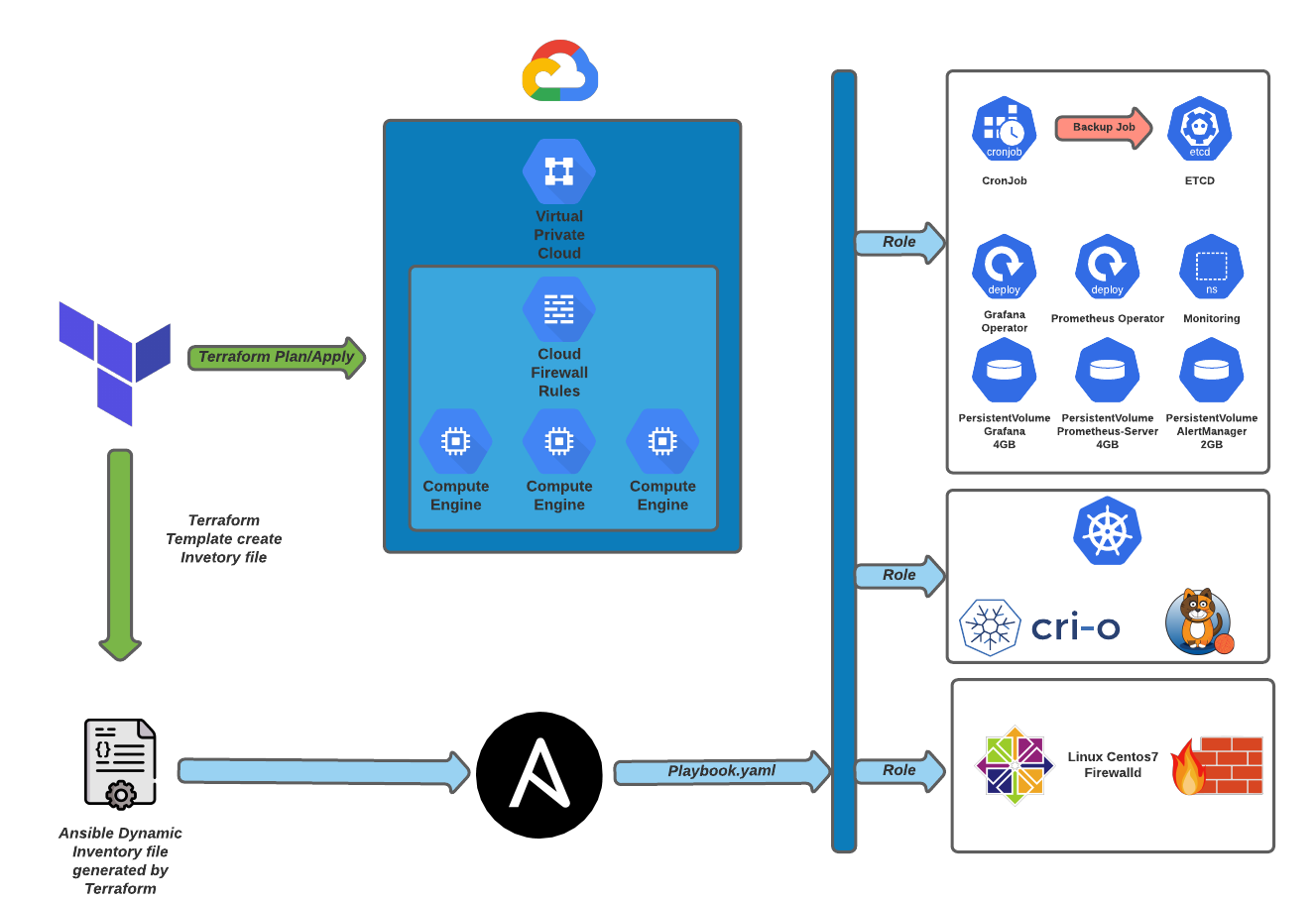-
Tecnologies
- Terraform https://terraform.io
- Ansible https://ansible.com
- Kubernetes https://kubernetes.io
- Calico Project https://docs.projectcalico.org/getting-started/kubernetes/quickstart
- CRI-O https://cri-o.io
-
Pre-req
- CentOS 7 or 8 machine
- JSON with Credentials of GCP to apply Terraform
- 15GB free on each machine on GCP
- Project on GCP
- Bucket on GCP created to Backend (statefile)
- SSH public key inserted on metadata of GCP
-
Architecture
Before execute terraform init you will need store the statefile on backend, to do this will need Bucket created on GCP.
terraform {
backend "gcs" {
bucket = "name_of_buckek"
prefix = "terraform/state"
}
}
terraform.tfvars contain all configuration of terraform, you can custom every parameter before execute plan/apply
| Name | Description | Type |
|---|---|---|
| auto_create_subnetworks | When set to true, the network is created in 'auto subnet mode' and it will create a subnet for each region automatically across the 10.128.0.0/9 address range. When set to false, the network is created in 'custom subnet mode' so the user can explicitly connect subnetwork resources. | bool |
| delete_default_internet_gateway_routes | If set, ensure that all routes within the network specified whose names begin with 'default-route' and with a next hop of 'default-internet-gateway' are deleted | bool |
| description | An optional description of this resource. The resource must be recreated to modify this field. | string |
| mtu | The network MTU. Must be a value between 1460 and 1500 inclusive. If set to 0 (meaning MTU is unset), the network will default to 1460 automatically. | number |
| network_name | The name of the network being created | any |
| project_id | The ID of the project where this VPC will be created | any |
| routing_mode | The network routing mode (default 'GLOBAL') | string |
| shared_vpc_host | Makes this project a Shared VPC host if 'true' (default 'false') | bool |
| Name | Description | Type |
|---|---|---|
| network_name | The name of the network where subnets will be created | any |
| project_id | The ID of the project where subnets will be created | any |
| secondary_ranges | Secondary ranges that will be used in some of the subnets | map(list(object({ range_name = string, ip_cidr_range = string }))) |
| subnets | The list of subnets being created | list(map(string)) |
| Name | Description | Type |
|---|---|---|
| network_name | Name of the network this set of firewall rules applies to. | any |
| project_id | Project id of the project that holds the network. | any |
| rules | List of custom rule definitions (refer to variables file for syntax). | list(object({ |
tags = ["kubernetes"] // Tag to Firewall rules on GCP
instances = 2 // Number of instances on Compute Engine GCP
machine_type = "e2-medium" // Type of machine to create (hardware and resources)
type = "pd-standard" // disk
size = "20" //disk size
family = "centos-7" // family of OS on GCP
project = "centos-cloud" // family of OS on GCP
hostname = "cka-node" // name and hostname of instance
startup_script = "sudo yum update -y && sudo yum upgrade -y" // Command to execute on startup of machine (ATENTION to this option, can broke the cluster on updates)
On root folder of project, just execute this commands
make terraform-init
make terraform-plan
make terraform-apply
Terraform create a host inventory file dynamically using temaples, you will need just run Ansible-playbook.
Before change the user of ssh user on group_vars
cd Ansible/group_vars/
vim kubernetes.yaml
linux_user: # Insert here the ssh user to run all playbooks.
This user need to be inserted on sudoers with no password on sudo. This configuration its default for cloud providers instances.
Now just run the ansible, on root folder of project
ansible-playbook -i Ansible/hosts Ansible/playbook.yaml
#default user grafana -> admin
#password
kubectl get secret --namespace monitoring grafana-operator -o jsonpath="{.data.admin-password}" | base64 --decode ; echo
Important information, the default services of grafana and prometheus is ClusterIP on this project, to external access you will need change to NodePort or LoadBalancer.
Pods:
kubectl get pods --all-namespaces
NAMESPACE NAME READY STATUS RESTARTS AGE
calico-system calico-kube-controllers-7f58dbcbbd-n4tzq 1/1 Running 0 90m
calico-system calico-node-2b4zp 1/1 Running 0 89m
calico-system calico-node-n7xzf 1/1 Running 0 90m
calico-system calico-typha-76944b47d9-sznnh 1/1 Running 0 89m
calico-system calico-typha-76944b47d9-tn4ks 1/1 Running 0 90m
kube-system coredns-558bd4d5db-lfbbl 1/1 Running 0 90m
kube-system coredns-558bd4d5db-nmxw6 1/1 Running 0 90m
kube-system etcd-cka-node-1 1/1 Running 0 90m
kube-system kube-apiserver-cka-node-1 1/1 Running 0 90m
kube-system kube-controller-manager-cka-node-1 1/1 Running 0 90m
kube-system kube-proxy-fd7sz 1/1 Running 0 90m
kube-system kube-proxy-qbxnc 1/1 Running 0 89m
kube-system kube-scheduler-cka-node-1 1/1 Running 0 90m
monitoring grafana-operator-7865594f84-n99fx 1/1 Running 0 88m
monitoring prometheus-operator-alertmanager-c74c85d66-x8g5q 2/2 Running 0 88m
monitoring prometheus-operator-kube-state-metrics-56cd79c5b9-lqwtd 1/1 Running 0 88m
monitoring prometheus-operator-node-exporter-mz69n 1/1 Running 0 88m
monitoring prometheus-operator-pushgateway-547c77db5f-ggzs5 1/1 Running 0 88m
monitoring prometheus-operator-server-5999c5d54-z7cz5 2/2 Running 0 88m
tigera-operator tigera-operator-86c4fc874f-4g2vv 1/1 Running 0 90m
Services:
kubectl get svc --all-namespaces
NAMESPACE NAME TYPE CLUSTER-IP EXTERNAL-IP PORT(S) AGE
calico-system calico-kube-controllers-metrics ClusterIP 10.102.212.175 <none> 9094/TCP 90m
calico-system calico-typha ClusterIP 10.96.78.197 <none> 5473/TCP 91m
default kubernetes ClusterIP 10.96.0.1 <none> 443/TCP 91m
kube-system kube-dns ClusterIP 10.96.0.10 <none> 53/UDP,53/TCP,9153/TCP 91m
monitoring grafana-operator ClusterIP 10.101.123.25 <none> 80/TCP 89m
monitoring prometheus-operator-alertmanager ClusterIP 10.111.22.195 <none> 80/TCP 89m
monitoring prometheus-operator-kube-state-metrics ClusterIP 10.102.245.87 <none> 8080/TCP 89m
monitoring prometheus-operator-node-exporter ClusterIP None <none> 9100/TCP 89m
monitoring prometheus-operator-pushgateway ClusterIP 10.109.106.185 <none> 9091/TCP 89m
monitoring prometheus-operator-server ClusterIP 10.103.74.130 <none> 80/TCP 89m
CronJob to backup ETCD
kubectl get cronjobs.batch -n kube-system
NAME SCHEDULE SUSPEND ACTIVE LAST SCHEDULE AGE
backup-etcd 30 14 * * 3 False 0 <none> 89m
